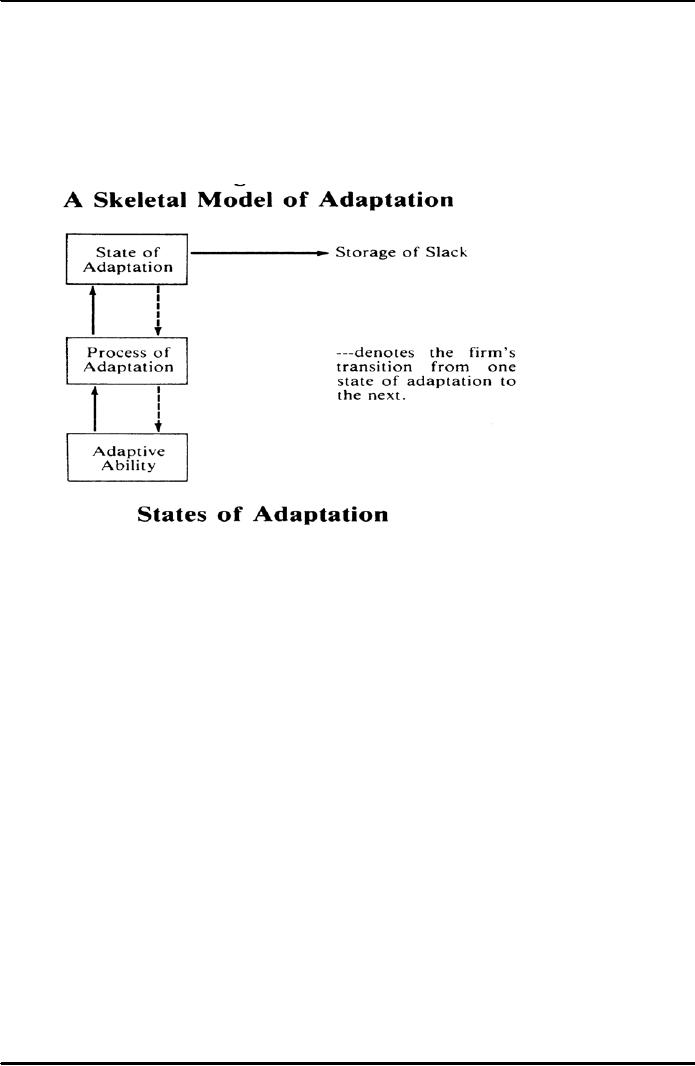 |
SKELETAL MODEL OF ADAPTATIONq |
| << PROSPECTORS |
| STRATEGIC CHANGE >> |

Change
Management MGMT625
VU
Lesson
# 25
SKELETAL
MODEL OF ADAPTATION
A state of
adaptation, in a biological sense
describes a sate of survival
for an organism. Analogously, a
state of
adaptation for a business
organization is one in which it can
survive the conditions of
its
environment.
There may be several niches
available to a firm for
surviving the conditions of
its
environment.
Simon
gives us a three modes that
are open to a system
1.
Passive insulation (Defender)
2.
Reactive negative feed back
(Analyzer)
3.
Predictive or Proactive adaptation
(Prospector)
Three
states of adaptation are
given by Chakravorti. He used the
terms as unstable state, stable state
and
neutral
state. All three states of adaptation
are viable. The unstable
state is the most vulnerable to
changes
in the
firm's environment, a neutral
state is the most vulnerable, and a
stable state vulnerable only
to
certain
environmental changes
In the unstable
state, a firm tries to
buffer itself from its
environment, as it is extremely susceptible
to
environment
to environmental changes. The
manager of such a firm,
concerned with the fragility of
the
firm's
adaptation is continuously on the lookout
for new buffering
arrangements. These firms
are called
defenders
and have narrow product-market domains, and
they seldom seek to make
major adjustments
in their
technology, structure or methods of operations. To
Miles and Snow such an
organization adapts
by simply
ignoring the environmental events or
demands.
A stable
state describes the state of
adaptation in which instead of buffering
itself from the
environment,
the firm is
open to it and, in fact offers a reactive
move in keeping with every
move of the environment.
The
firm reacts to environmental
changes and complies with
environmental mandate. Called an
analyzer
, by Miles
& Snow, such a firm has
a buffered core like the defender,
but unlike the defender it also
has
extensive
market surveillance mechanism
that enable it to imitate the best of
products and markets by
others.
60

Change
Management MGMT625
VU
In a neutral
state, a firm can withstand
most environmental changes
because they have been
anticipated
before
their occurrence and the firm
has invested in the requisite
adaptive ability. For Miles
and Snow
such types
of organizations are called
"prospectors" which are in
continuous search for
market
opportunities.
They often create changes in
their environment, to which
their competitors must respond.
"A true
prospector is almost immune from the
pressures of a changing environment
since this type of
organization
is continually keeping pace
with change, and...frequently
creating change itself",
accords
to Miles
& Snow.
All the three
states of adaptation are
viable ways of coping with the
environment. Defender,
Prospector
and
Analyzer are all "stable"
form of organizations, and manager
chooses to pursue either of
these
strategies
to cope effectively with its
competitors. "If management chooses to
pursue one of these
strategies,
and designs the organization accordingly,
then the organization may be an
effective
competitor
in the particular industry over a
considerable period of time"
All state of
adaptations does not have the
same immunity from
environmental changes. The
neutral state
has the
highest immunity, followed by the
stable and unstable states. A firm
seeking to ensure its
future
should
prefer a neutral state of
adaptation over the other
two states. But then the
fundamental question
arises:
Why do not all firms show
for the preference for such an
ideal option? (Similar to the
teacher-
student
environment metaphor, why cannot all
students get the same grade or a grade?).
The answer has
two
parts:
1. The
state of adaptation depend on the firm's
resources that it commands
(adaptive ability)
2. The
nature of management processes within
these firms (process of
adaptation) influences the state
of
adaptation
sought
Determinants
of Adaptive ability
How
can adaptability be improved?
Lawrence & Lorsch gave the concept as
differentiation and
integration.
Improving on firm's differentiation and
integration would increase
its adaptability.
Christenson
called this as level of
organization which again is
composed of differentiation and
integration,
and then relabeled as
Organizational Capacity.
The
organization capacity measures the
information processing ability of
firm, and is an
aggregate
measure of
the human resources of that
firm. Andrew suggests that
adaptation is measure by the
nature
and
extent of the firm's material
resources. Miles and Cameroon
defines the same as
Environmental
Receptiveness
Cluster which influences the
state of adaptation. The cluster
includes two things:
1. Resource
scarcity the extent to which elements in
the input of an org. lean in
needed resources
2. Internal
resources defined as the generalizability
of a firm's core technology
and expertise, and the
extent of
its slack. Material resources
include inputs like finance
and technology.
The
Process of Adaptation
The
process of adaptation consists of
two sub-processes: Adaptive
generalization and Adaptive
Specialization
i)
Adaptive
Generalization
It is the
process of improving the goodness of
fit in a given state of
adaptation. It refers to the
rationalization
of processes and structure using Material
Capacity (MATCAP) and
Organizational
Capacity
(ORGCAP) for moving to the
nearest adaptive fit.
Adaptive generalization refers to the
process
that
improves the survival potential of the
organization. Managing slack is the key
to adaptive
generalization.
This requires that an old
fit be consciously disturbed for the
sake of new and higher
fit.
61

Change
Management MGMT625
VU
(Require
MATCAP & ORGCAP)
ii)
Adaptive
Specialization
This
involves the choice of strategy appropriate to the
environment and resources of the firm,
and the
design of a
matching structure. An important part of
strategic management is adaptive
specialization,
which
involves:
1. Managing
the choice of purpose for the firm so as
to exploit its material and
organizational capacities
optimally
2.
Minimizing the misfit, in the match
between the chosen purpose
and the firm's ORGCAP
and
MATCAP
Adaptive
specialization involves formulation of
strategy keeping in view firm's
resources. Adaptive
generalization
and adaptive specialization follow
each other in a cyclical
pattern.
References:
The above
lecture notes are
essentially prepared from the following
articles; excerpts and clippings
are
also
taken from the same:
Chakravarthy
Balaji S, "Adaptation: A Promising
Metaphor for Strategic Management,"
The Academy
of
Management Review, Vol. 7,
No. 1 (Jan., 1982), pp. 35
44
Miles,
Raymond E, Snow Charles C et
al, Organization Strategy Structure
and Process, The
Academy
of
Management Review, Vol. 3,
No. 3 (Jul. , 1978), pp.
546-562
62
Table of Contents:
- Introduction to Change Management
- BENEFITS AND SIGNIFICANCE OF CHANGE MANAGEMENT
- KURT LEWIN MODEL: ASSUMPTIONS AND IMPLICATIONS
- IMPLICATIONS OF KURT LEWIN MODEL
- SOME BASIC CONCEPTS AND DEFINITIONS
- TRANSACTIONAL VS. TRANSFORMATIONAL LEADERSHIP
- THEORIES OF CHANGE IN ORGANISATIONS
- Life cycle theory
- Teleological theories of Change
- Dialectical theories of change
- A DIALECTICAL APPROACH TO ORGANISATIONAL STRATEGY AND PLANNING
- LIMITATION OF DIALECTICS; DA AND DI
- THEORIES OF CHANGE IN ORGANISATIONS
- APPLICATION OF EVOLUTIONARY THEORY
- FURTHER APPLICATION OF EVOLUTIONARY T
- GREINER’S MODEL OF ORGANISATIONAL– EVOLUTION AND REVOLUTION
- GROWTH RATE OF THE INDUSTRY
- COORDINATION
- ORGANISATION ECOLOGY
- CLASSIFICATION OF ORGANIZATIONAL SPECIES
- FOOTNOTES TO ORGANISATIONAL CHANGE
- SOME COMPLEXITIES OF CHANGE
- ORGANIZATIONAL ADAPTATION
- PROSPECTORS
- SKELETAL MODEL OF ADAPTATIONq
- STRATEGIC CHANGE
- Management Styles and Roles
- SYMBOLIC PROCESSES
- COMMUNICATING CHANGE